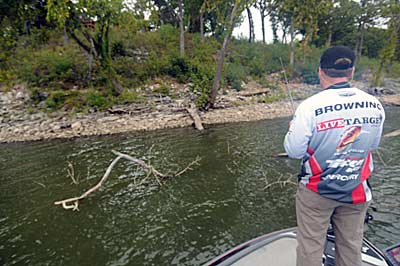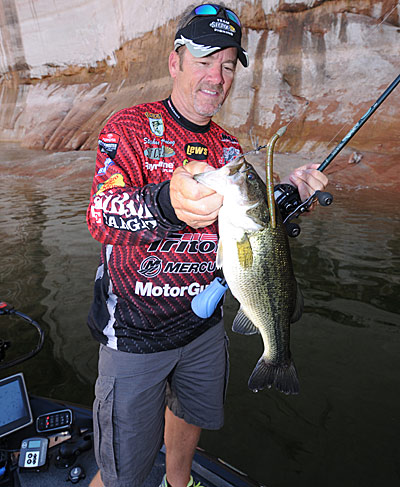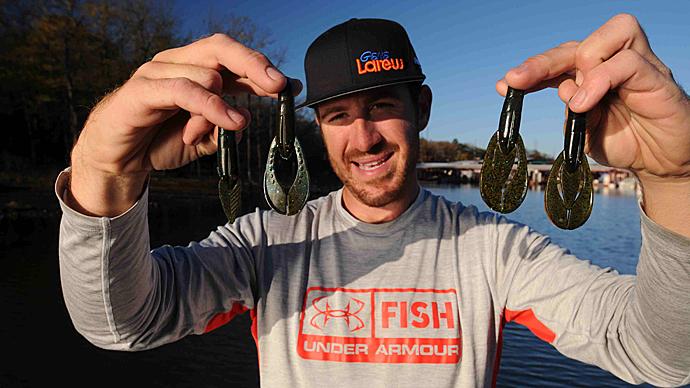
Casting is the universal way to throw baits in all types of fishing, but three unique lure deliveries originated and became standard techniques in bass fishing.
During competition and practice days, Major League Fishing (M.L.F.) pro Stephen Browning frequently performs all three of bass fishing's unique lure deliveries: flipping, pitching, and punching. BassResource and other internet sources offer plenty of articles and videos describing the step-by-step procedures for each technique for you to learn. However, this article will focus on Browning's tips for applying the following lure deliveries.
Flipping
While the popularity of flipping has declined throughout the years, Browning is still an avid flipper. "I flip a lot, especially at laydowns and things of that nature," he says. "The biggest thing about flipping is hand-to-hand contact. If I need to get a bait in a particular place or hole, I prefer the flipping technique over pitching for sure." The Arkansas pro prefers flipping into the heart of any thick cover and the small holes behind reed lines.
Flipping produces best for Browning when he is fishing off-color water. Then, he can position his boat tight to the cover to make his precise lure deliveries without spooking a bass in its hideout.
Browning believes the length of line let out to swing the bait is the key to flipping accurately. "Typically (when letting out line), I try to keep the bait above the rod handle itself, so the length I like to use is between the first guide on my rod and the reel,” he says. Browning suggests he doesn't need to let out much line because he usually only flips in 3 to 5 feet of water.
A long rod is also a key to Browning's flipping tactics because he can keep in close contact with his lure after it enters the cover. "It allows me to follow the bait down when it hits the water and keep up with the loose line (as the bait falls),” he says. “You can feed the bait down in the water with that longer rod.” Browning flips with a 7-foot, 11-inch St. Croix Legend X, heavy moderate fast rod he matches with a Lew’s Super Duty 8.3:1 gear ratio baitcast reel.
The tournament veteran depends on heavy line when flipping his lure into thick cover. "Generally speaking, you will maybe have 8 to 10 feet of line out from your rod tip, and if you lean back on a bass with 14- to 16-pound line, you are probably not going to be able to get that fish out of heavy cover," he says. Browning discloses he usually flips with 25-pound Gamma Fluorocarbon Edge.
The touring pro favors a heavy bait for flipping because it is easier to place in tight spaces and falls quickly to trigger reaction strikes. His favorite lures include a 1/2- or 3/4-ounce Strike King Hack Attack Flipping Jig and a Texas-rigged Z-Man Palmetto BugZ weighted with a 1/2- or 5/8-ounce tungsten sinker.
Pitching
“The biggest thing about pitching is that you can cover more water," Browning says. “You are fishing for that more aggressive bite, more so than with flipping.”

The M.L.F. Builders FirstSource Patriot Cup winner suggests pitching is more suitable for clearer water. "You can back off and don't necessarily have to get right on top of the fish," he says. Browning estimates most of his pitches are about 30 feet from his target.
Browning scales down on the weight of his lures and sinkers when pitching, depending on the cover's thickness and the fish's mood. He opts for light weights such as 1/4, 5/16, and 3/8 for pitching to thinner cover and moody bass but switches to heavier weights for thicker cover and aggressive fish.
The four-time B.A.S.S. winner believes determining the fish's mood is the key to pitching. If bass are inactive, Browning can pitch a finesse bait such as the Z-Man ZinkerZ stick worm to the cover. "Pitching is a power fishing technique, but it is a little bit more finesse than flipping," he says. The Z-Man Palmetto BugZ is also one of Browning’s favorite lures to pitch.
Browning’s gear for pitching consists of a 7-foot, 4-inch St. Croix Legend Elite heavy fast rod and Lew’s Tournament MP 8.3:1 baitcast reel spooled with 16- or 20-pound Gamma Fluorocarbon Edge.
Punching
Browning gains access to bass hiding under thick aquatic vegetation by punching his lures through the weed mat. “Punching can actually be through submerged grass as well, not necessarily grass mats,” he says. “I absolutely love punching grass, whether it is deep or shallow.”
Browning can either crash through the mat with a lighter weight or push through the weed mat with a heavy weight. "You can get a lighter weight through a heavier mat by making that bait enter from a higher level," he says. "You can take a smaller weight and flip it up high and let it crash down through that cover and let it go down. With a heavier weight, you are making more of a subtle presentation and letting that weight break through."
According to Browning, the lure's descent rate once it punches through the mat is the key to triggering strikes. “You have to have a weight that will get through whatever cover you are fishing," he says. However, a heavy lure can sometimes fall too fast through a bass' strike zone, so Browning tries to control the fall rate by slowing down his reel spool. He makes the bait fall "a hair slower" by thumbing the reel after the lure passes through the mat.
Browning suggests that beginning anglers who want to try punching need to think heavy. "You will have to invest in a big rod, line, and a reel that will handle 50- to 80-pound braided line.”
A heavy rod is essential, but Browning warns against buying too stiff of a rod. "A heavy action rod that doesn't give much will rip a hook out of a fish's mouth instead of allowing that fish to grab the hook so when you set the hook, it stays in the bass’ mouth,” he says. “Sometimes too heavy of a rod will flex a hook and not allow it to penetrate the fish."
Browning punches through mats with a 7-foot, 11-inch Legend X heavy moderate fast rod and a Lew’s HyperMag 8.3:1 baitcast reel spooled with 50- or 80-pound Gamma Torque Spectra Braid.
His favorite combo for punching through mats is a Strike King Hack Attack Jig tipped with a Z-Man Palmetto Bug. He will also Texas-rig the Palmetto Bug matched with a weight ranging from 3/4- to 2 ounces. Browning emphasizes using a jig or worm hook with heavy gauge wire because you will need a stiff hook that won't flex when you have to horse the bass out of the weeds.
BassResource may receive a portion of revenues if you make a purchase using a link above.




